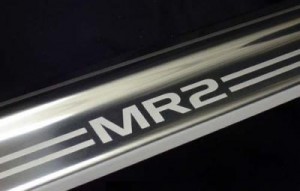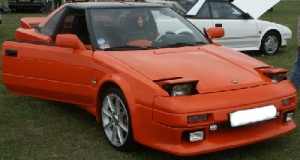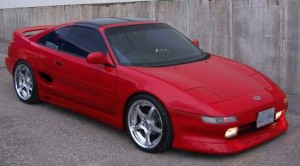Dissecting the Toyota MR2
By Shenron on May 26, 2008 with Comments 2
Japanese carmakers are not really popular when it comes to manufacturing sports cars. Japan-made cars are known for their practicality. But when Toyota released the MR2 in 1984, it surprised and awed sports car enthusiasts in the world.

Toyota MR2 was not primarily foreseen by its maker to become a sports car. Toyota wanted to have a good performance vehicle that maintains fuel economy. How the car was released as a full blown sports unit, nobody knows. The unit turned out to be one of the most economical but the most efficient sports car ever built.
A Good Look at the Car
Toyota MR2 was named based on the car’s general design. Midship Runabout 2-seater is what MR2 means. Toyota MR2 is a mid-engine car with a rear-drive design, and as its name connotes, it is a 2-seater car. Aside from this, the car possesses the characteristics of a car that meet the sports car criteria. It has a powerful engine, efficient handling, good transmission and lightweight. MR2 was a hit because of the fact that it is cheaper than other sports car, but it does lag when it comes to sports car standard.
Mass production of the Toyota MR2 started in 1984 and ended in 1997. The car comes in four designs which evolved through the years. The first Toyota MR2 ever released is the AW11. Together with the AW11, Toyota also released a JDM unit, the AW11 unit. The JDM or Japan Domestic Unit is designed for the Japanese market. The only difference between the AW11 and the AW10 is the engine. The JDM MR2 uses a more economical engine.
The Toyota MR2 is powered by an I4 engine while another version of its second release is fitted with a V8 for racing purposes. All MR2’s have OHCS or Overhead Camshaft systems a 16-valve configuration. The first release uses a 1587 4A-GE I4 engine for the AW11 and a 3A-U 1452 cc for the AW10. Both engines are supercharged and use the fuel injection system. The AW11 is lightweight. It weighs approximately 1000 kg. Transmission wise the early MR2’s either use a 5-speed stick or a four speed automatic.
Toyota MR2 Evolution
After the Toyota MR2 AW11 and AW10 were released Toyota made some moves to improve the MR2’s performance. Although the AW10 was not very popular, the AW11 was a big hit. One of the best improvements done to the MR2 AW11 model was changing its transmission from C50 to C52. This further improved the dependability of the unit. Aside from this, Toyota also improved the MR2’s engine. The old 4A-GE was innovated to become the new engine for the MR2. The 4A-GZE was made possible by adding the SC-12 supercharger and an intercooler to the 4A-GE block. This increased the MR2’s acceleration doing 100 km/h in approximately 7.0 seconds.

In 1990, the new generation of the Toyota MR2 was produced, the Toyota MR2 Mark II. This model is also called the MR2 SW20. The SW20 is still equipped with I4 engines with Overhead Camshaft but no longer uses superchargers. This new MR2 unit uses turbo charger, making its acceleration better, way beyond its predecessor. The MR2 SW20 is fitted with a more powerful 1998 cc 3S-GTE turbocharged engine while the US MR2 MII design uses a 5S-FE 2164 cc engine. Aside from this, the exterior of the SW20 is totally different from the AW11. The SW20 is bigger, longer and wider.
The latest addition to the Toyota MR2 series was released in 1999. The Toyota MR2 ZZW30 a.k.a Toyota MR-S is a convertible. This model is designed to be slick and light. Like its predecessors, the MR-S maintained the overhead camshaft and 16-valve configuration. The engine is still an I4, but unlike the other MR2s, this unit’s engine is made of aluminum for it to be more lightweight. MR-S’s engine is a 1744 cc IZZ-FED. The MR-S also employed the VVT-i system, the WW20 MR2. The MR-S is the lightest MR2 model weighing only 975 kg. The transmission option for the MR-S is also more versatile. Aside from the 5 speed manual transmission there is the option of getting the 5 or 6-speed SMT or Sequential Manual Transmission.
Engine, Turbo and Transmission
The I4 engine which is the MR2’s engine of choice is not as powerful as the V8 but powerful enough to speed-up the lightweight MR2. The MR2 a different I4 for every new model release each one better than the previous one. The 4A-GE engine of the AW11 produces 118 HP – 130 HP of power depending on the country where the unit is manufactured. The latest engine IZZ-FED for the MR-S produces 138 HP of power. The MR2’s engine is further enhanced by Variable Valve Timing with intelligence (VVT-i) system which maintains the performance of the I4’s 16 valve OHCS.

The MR2 started with a supercharge engine unit which worked just fine. The acceleration of the AW11 propels the unit from rest to 100 km/h in 6.7 seconds. Then came the AW20, which is now turbo charge. The MR2 turbo, aiding its new 5S-FE engine, accelerated the MR2 MII from 0 to 100 km/h in 5.6 seconds. Due to the excellent performance of the turbocharged MR2, manufacturers now produced turbo chargers that could fit with the AW11 unit.
There is not much difference when it comes to transmission design with the AW11 and the AW20. Both MR2’s are available at either a 5-speed manual transmission or a 4-speed automatic transmission. The transmission breakthrough came with the MR-S. The Sequential Manual Transmission (SMT) on the MR-S diminishes the energy transfer loss observed with the H transmission. This application is frequently used on race cars because it is less susceptible to driver error, and gear transfer is faster compare to the clutch mechanism.
Tuning Parts and Accessories
Another major advantage of the Toyota MR2 is the availability and practicality of tuning and customizing parts. The MR2 is designed to be easily customized and innovated. The SW20 could be even fitted to look like the Ferrari F355. A turbo charger could also be installed to increase the performance of the supercharge AW11. The SW20 and the MR-S could be fitted with a V8 or a V6 engine.
Aftermarket parts for the MR2 could be found through a simple internet search. Included in some packages are body kits and spoilers which improve the cars aerodynamics. Flashy lighting system could also be fitted to this unit without doing as much work as with other cars. The MR2’s lightweight frame could even be improved by replacing external parts like its hood. All in all the MR2 is one car that won’t give you problems when it comes to looking for the right parts and accessories.
Filed Under: General

I am in the process of creating a 3S-GTE Camry but the owner wants to keep it automatic I have not found any sites that discuss this but this article did (AW20) We are not looking for track days (he’s heavy & bald with 3 kids) but something sturdy in DC traffic, but calm enough for the wife to drive. Is the pinout positions on the GT4 motor capable of controlling a automatic?????
Well, Well, that I’m not sure about, still I don’t see much of a problem in it.
You’d better ask that to a professional mechanic in the area as I cannot be very sure.